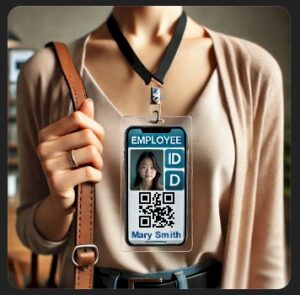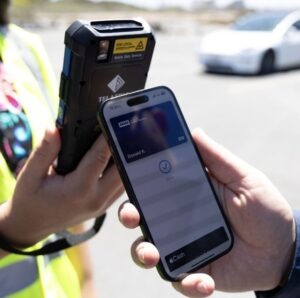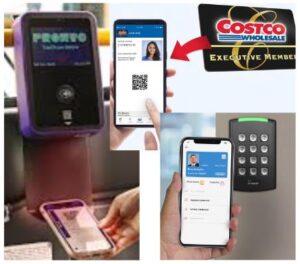At Telaeris, our handheld readers validate credentials or badges stored in a physical access control system. In the past few years, we have seen many customers deploy mobile credentials at the entrances to their facilities. The next logical step for them is to ensure that the handheld badge readers they already purchased can support these same credentials.
As we work with our clients, it has become clear that there are many misconceptions and misunderstandings about mobile credentials. This article is a quick primer on the subject, including what mobile credentials are used for, how they work, and items to consider when deploying them.
Use Cases
Mobile credentials are simply digital versions of electronic ID documents stored on your smartphone – either iOS or Android. These digital credentials are used to replace:
-
- Employee access control badges
- Public transportation cards
- State or national identification cards
- Health insurance cards
- Club or credit cards
- Event tickets
- and more…
Mobile Credential Technologies
Because cell phones are so ubiquitous in people’s lives, being able to use one to store digital versions of cards in your wallet is incredibly convenient for ease of use and access. These mobile credentials can generally be presented for use in one of three ways:
- 1D or 2D barcodes, including QR codes and others, from the phone screen
- NFC – a close-range RFID standard, compatible with ISO 14443 and ISO 15693 badges operating at 13.56 MHz
- BLE – a longer range 2.4 GHz RFID interface primarily used for connecting devices
People access these mobile credentials from one of two places stored on a smartphone:
- An application on the smartphone, such as Costco’s membership app or the San Diego Pronto bus/trolley payment app.
- Apple, Google, or Samsung Phone Wallet applications which securely store a collection of credentials, including credit cards and access control badges.
Typically, a company will sign up for mobile access control credentials with the credential issuer: companies like HID, Farpointe, AMAG, or LenelS2, to name a few. Be aware, though, that the mobile access control credentials from one company will not work with those from another company’s wall reader.
Universities Driving the Adoption
As phones are often in people’s hands, using them for access control makes sense. And the next generation of workers are being trained to use mobile credentials as many universities now eschew issuing a physical ID card in lieu of a student app. These apps’ capabilities include the following:
-
- Class registration
- Schedules
- Meal points
- Event entry
- Access control
Companies issuing mobile credentials often give steep discounts to universities, knowing that they are essentially priming the market for future adoption in the corporate world. Of course, with 100 to 20,000 new student credentials guaranteed every year, recurring revenue is guaranteed.
Pluses and Minuses of Mobile Credentials

Credential-issuing providers will tell prospective customers that mobile credentials are better: more convenient, more secure, more economical, more scalable, environmentally sustainable, and offer “future-proof” technology. But like any new technology, there are always pros, cons, and unintended consequences. An excellent example of this is the lesson learned by cities that deployed new energy-efficient LED street lights, only to find that when a storm filled the street lights with snow, the LED lights didn’t generate enough heat to melt the snow, thus causing massive traffic jams.
Hopefully, the list below will advise companies and help them learn from some of the mistakes of their predecessors.
Pros
Some of the significant benefits of mobile credentials include:
-
- Provide the ability to have a “badgeless” infrastructure (e.g., universities)
- Reduce the production, distribution, and disposal of physical cards
- Web interface to issue new badges
- “Future-proof” technology with security enhancements
- People are much less likely to forget their phone than their badge
- Many badge technologies are broken
- Perceived higher security
- Convenience, convenience, convenience
For our XPressEntry solution, mobile credentials can also make mustering more convenient. In case of an actual emergency, employees are much more likely to grab their phones than their badges. Similarly, for other scenarios, such as offsite events or training, people are much more likely to have their phone, not thinking they might need an employee ID.
Cons

However, there are still many issues to be aware of if you make the transition:
-
- Mobile credentials can lock customers to use one provider for door readers.
- New mobile credential-enabled readers might not support existing badges.
- Mobile credentials might not function on a phone with a dead battery.
- You will likely still require your badge infrastructure for employee visual identification.
- Unclear security risks.
And, of course, there are a plethora of cost concerns:
-
- “Virtual” credentials can cost as much or more than physical credentials
- Recurring (annual) charges for mobile credentials
- Recurring (annual) charges for issuing portals
- Upgrade costs for physical wall readers to support the new credentials
A Specific Example: HID Global Mobile Credential Deployment
HID Global is the industry leader in access control. They have multiple ways to store and present their PACS credential:
-
- Apple Wallet
- Google Wallet
- HID’s mobile App available for both iOS and Android
As one of the worldwide leaders in badges and mobile credentials, HID has a very mature infrastructure. They provide portals that allow companies to create mobile credentials for their employee/contractor/student populations. Very importantly, the workplace security office now issues unique digital badges via email. These are subsequently downloaded and securely stored on users’ devices, eliminating many cardholder trips to the badging office.
HID’s latest line of wall-mounted access control devices, the HID Signo™ Readers, can read LF, HF, NFC, and BLE technologies. They have several patents for their technologies, including a Twist and Go approach to opening doors using Bluetooth. Employee phones with the HID app are all employees need to gain access to the facility, which is incredibly convenient!
One of HID’s customers encountered an unintended consequence when they migrated to mobile credentials. They discovered that the new Signo readers could not decode their large population of CasiRusco badges. Fortunately, we were able to solve their problem by deploying some insightful and clever engineering.
Additionally, this customer was able to use Telaeris’ XPID200 Handheld Badge Verifier to read their mobile credentials and their existing Casi badges for both emergency mustering and employee identification. It is important to note that this device is uniquely certified by both HID and Apple as compliant with all of HID’s credentials, including Prox, iClass, SEOS, and HID’s Mobile Credentials.
We hope this digression into the new world of mobile credentials has provided you with insight and guidance. If you have any questions or would like to discuss how we can help you deploy handheld solutions working with your mobile credentials from any provider, don’t hesitate to contact us at [email protected].


